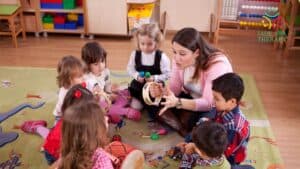Artistic expression can provide immense benefits for children with autism spectrum disorder (ASD). However, it’s not always easy for parents and caregivers to provide the arts education autistic children need. This comprehensive guide will explore the advantages of artistic pursuits for autistic kids, examine the challenges, and offer tips to successfully integrate the arts into your child’s life. Artistic skills encompass a spectrum of creative abilities, from painting and drawing to sculpting, photography, and beyond

The Benefits of Artistic Expression for Autistic Children
Engaging in the visual arts, music, dance, and other creative outlets offers a wide range of perks that can be difficult to find elsewhere for autistic children. Benefits may include:
Communication Without Words
Many autistic individuals struggle with verbal expression. The arts give them an avenue to communicate their inner world nonverbally. A child who can’t find the words to describe their thoughts and feelings may be able to express themselves beautifully through painting, sculpture, dance moves, or song lyrics.
Social Growth Opportunities
Artistic activities are often communal in nature. Participating in a band, theater troupe, dance group, or art class requires interacting with others and fosters engagement. In fact, some therapists use arts-based programs specifically to build social skills in autistic children.
Building on Strengths
After an autism diagnosis, the focus is often on a child’s deficits. The arts allow autistic kids to leverage their strengths. Many autistic children demonstrate exceptional talents for music, visual arts, and performance.
True Inclusion
It can be challenging to fully include autistic kids in typical social activities. But in artistic settings, autistic children may be able to integrate seamlessly into a neurotypical peer group. Their differences become irrelevant, allowing them to be valued for their unique contributions and abilities.
Lifelong Skills
Autistic children are constantly learning new skills they later outgrow. But artistic passions can provide lifelong enjoyment and fulfillment. An autistic teenager may lose interest in the games they loved as a young child, but music and art remain relevant from childhood through adulthood.
Challenges for Autistic Children in the Arts
While higher functioning autistic children may succeed in mainstream arts programs alongside neurotypical peers, those with more support needs often struggle to access arts education. Some of the obstacles include:
Fine Motor Difficulties
Many autistic individuals have underdeveloped fine motor control. This can make it hard to draw, use scissors, or play instruments requiring precise finger movements. With time and practice, these skills usually improve, but often not at the same pace as typical children.
Language Processing Issues
Following multi-step verbal instructions can be difficult for autistic kids. An art teacher saying “Turn to page 3 and draw the cat” may need to provide visual cues or other modifications for autistic students. One-on-one support is often necessary.
Meeting Instructor Expectations
Private art and music teachers may get frustrated with the slower pace autistic students need. If instructors lack training in adapting lessons for neurodiverse learners, tensions may arise.
Group Learning Challenges
Including an autistic child in a dance recital or play can be tough. If they fall behind or get overwhelmed, it may disrupt the entire group. Without proper support, these communal arts activities may not be feasible.
Gross Motor Difficulties
Many autistic children have underdeveloped gross motor skills. This makes it hard to excel in dance or play instruments requiring precise bodily movements. Extra coaching is usually needed to succeed in these artistic endeavors.
Perhaps the biggest obstacle is the common view that mastering daily living skills should take priority over arts education for autistic children. But with some creativity and the right support, most autistic kids can access and benefit enormously from artistic expression.
Models for Involving Autistic Kids in the Arts
There are several different approaches to providing arts education for autistic children:
Inclusive Arts Programs
Ideally, autistic students will be fully included in mainstream school arts classes with neurotypical peers. But this requires instructors to implement Universal Design for Learning techniques so all students can participate at their level. With supports like visual cues, fidget toys, and one-on-one assistance, inclusion can work beautifully. But it takes effort to make it succeed.
Disability Arts Programs
Arts programs designed specifically for children with disabilities allow autistic students to avoid the stigma and challenges of mainstream settings. With aides available to provide individual support, autistic children can thrive. However, expectations and skill development may be lower than in inclusive programs.
Arts Therapies
Approaches like music therapy, art therapy, and dance therapy aim to build social, communication, and coping skills through artistic activities. While research shows these therapies benefit autistic children, the focus is seldom on building artistic technique or talent.
Private Instruction
One-on-one art or music lessons allow for fully personalized and ability-focused instruction. While expensive, private lessons with a teacher experienced in working with neurodiverse students can unlock an autistic child’s potential. Parents can also provide quality arts instruction at home if properly equipped and prepared.
Tips for Supporting Your Child’s Artistic Development
Every autistic child’s skills and needs are unique. But the following tips can help parents and caregivers spur artistic growth:
- Assume competence. A child’s verbal or developmental delays do not dictate their artistic abilities. Many nonverbal autistic people have become highly successful artists and musicians.
- Encourage creativity. Avoid cookie-cutter art projects. Guide children to make their own aesthetic choices and express themselves through their art.
- Advocate for inclusion. Push for your child to be included in mainstream arts classes with proper supports. Inclusion provides rich learning experiences.
- Start early. At the first signs of interest, enroll your child in music lessons, arts camps, or other skill-building activities. This builds readiness for later participation.
- Utilize community resources. Attend museum art workshops, theater performances, and music events together. This introduces your child to artistic pursuits.
- Make art at home. Have supplies available for open-ended art and music activities you can enjoy together. Don’t force projects, just enable your child to explore.
In-Home Applied Behavior Analysis Therapy in Maryland
At Jade ABA, we provide customized ABA therapy programs in Maryland right in your home to help autistic children build skills for lifelong success. Our experienced therapists use research-backed techniques tailored to each child’s unique needs. We’d love to partner with you to unlock your child’s potential in all areas—including artistic expression!
Get started today by calling (410) 616-0901 or emailing info@jadeaba.org.
Our outstanding in-home ABA therapy services help autistic children thrive. Contact us now to learn more!
References
Edwards, B. M., Smart, E., King, G., Curran, C.J., Kingsnorth, S. (2020). Performance and visual arts-based programs for children with disabilities: a scoping review focusing on psychosocial outcomes. Disability and Rehabilitation, 42(5), 574-585. https://doi.org/10.1080/09638288.2018.1503734
Janzen, T. B., & Thaut, M. H. (2018). Rethinking the role of music in the neurodevelopment of autism spectrum disorder. Music & Science, 1, 2059204318769639. https://doi.org/10.1177/2059204318769639
Newman-Godfrey, A., & Stichter, L. (2017). Visual arts curriculum for students with autism spectrum disorder. In Chiang, H.-M. (Ed.), Curricula for Teaching Students with Autism Spectrum Disorder (pp. 161-193). Springer International Publishing. https://doi.org/10.1007/978-3-319-69983-7_8



